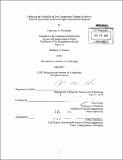| dc.contributor.advisor | Linn Hobbs. | en_US |
| dc.contributor.author | Whisenant, Lawrence A | en_US |
| dc.contributor.other | Massachusetts Institute of Technology. Dept. of Materials Science and Engineering. | en_US |
| dc.date.accessioned | 2013-01-07T21:23:12Z | |
| dc.date.available | 2013-01-07T21:23:12Z | |
| dc.date.copyright | 2012 | en_US |
| dc.date.issued | 2012 | en_US |
| dc.identifier.uri | http://hdl.handle.net/1721.1/76128 | |
| dc.description | Thesis (S.B.)--Massachusetts Institute of Technology, Dept. of Materials Science and Engineering, 2012. | en_US |
| dc.description | Cataloged from PDF version of thesis. | en_US |
| dc.description | Includes bibliographical references (p. 72-74). | en_US |
| dc.description.abstract | Egyptian faience, a glazed, non-clay based ceramic material, is found throughout Egypt in a time range pre-dating the Predynastic Period (5500 - 3100 BCE) and extending well beyond the Roman Period (30 BCE - 641 CE). One of the most monumental feats of faience production and one of the first examples of mass production in human history is the collection of approximately 36,000 faience tiles from the Step Pyramid of the Third Dynasty Pharaoh Djoser (2667 - 2648 BCE). Based on past research, these tiles have been supposed to be glazed in a range of firing temperatures from 850°C to 900°C. Recent research of efflorescence-glazed tiles has introduced the possibility that the tiles from Djoser's Step Pyramid may have been glazed at far lower temperatures between 250°C and 350°C, possibly due to the phosphorus content of the tiles. The non-destructive analysis of a tile from the Djoser Step Pyramid, reported in this thesis, has yielded results using methods of x-ray fluorescence, environmental scanning electron microscopy, x-ray energy dispersive spectroscopy, x-ray diffraction and microcomputed tomography. It appears that the tile was glazed by the method of "application." There is evidence that may support hypotheses of low temperature glazing, though the phosphorus content of the faience core and of the glaze does not fully explain the phenomena. | en_US |
| dc.description.statementofresponsibility | by Lawrence A. Whisenant. | en_US |
| dc.format.extent | 74 p. | en_US |
| dc.language.iso | eng | en_US |
| dc.publisher | Massachusetts Institute of Technology | en_US |
| dc.rights | M.I.T. theses are protected by
copyright. They may be viewed from this source for any purpose, but
reproduction or distribution in any format is prohibited without written
permission. See provided URL for inquiries about permission. | en_US |
| dc.rights.uri | http://dspace.mit.edu/handle/1721.1/7582 | en_US |
| dc.subject | Materials Science and Engineering. | en_US |
| dc.title | Exploring the possibility of low temperature glazing in faience from the Djoser Step Pyramid through compositional analysis | en_US |
| dc.type | Thesis | en_US |
| dc.description.degree | S.B. | en_US |
| dc.contributor.department | Massachusetts Institute of Technology. Department of Materials Science and Engineering | |
| dc.identifier.oclc | 821215570 | en_US |
